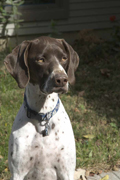
May 2007
Pet Waste and Clean Water
P et waste can directly affect the quality of our waterways if not handled correctly. If the waste is left to decay on the sidewalk or lawn, it can be carried into storm drains by water from rain or melted snow. The water entering these storm drains does not travel to a sewage treatment plant. Instead, this water is carried directly into our waterways, bringing with it pollutants picked up along the way.
et waste can directly affect the quality of our waterways if not handled correctly. If the waste is left to decay on the sidewalk or lawn, it can be carried into storm drains by water from rain or melted snow. The water entering these storm drains does not travel to a sewage treatment plant. Instead, this water is carried directly into our waterways, bringing with it pollutants picked up along the way.
When the pet waste washes into a waterway, it decays and uses up oxygen while releasing ammonia. Low oxygen levels and ammonia in a warm season can kill off aquatic life in waterways. The pet waste also contains nutrients, which promote weed and algae growth. Excessive amounts of nutrients in water will cause the water to become green and cloudy, commonly referred to as eutrophication. Pet waste also carries disease-causing organisms, making the water unsafe for swimming and drinking.
To prevent pet waste from becoming a problem, pet owners should regularly pick up after their pets. Be particularly vigilant of areas near wells, sewer inlets, ditches, and waterways. Children seem to be the most frequent victims of disease from pet waste, so special attention should also be given to play areas.
There are a few options to consider when deciding on the proper method for disposing of pet waste. One thing you should not do is put the waste in the compost pile. Below are three commonly used disposal techniques to choose from:
Flush down the toilet
- Toilet water goes to sewage treatment plants where most pollutants are removed.
- To prevent plumbing problems, don’t flush miscellaneous debris such as rocks, twigs, and cat litter.
- Cat feces may be scooped out and flushed, but litter must be placed in a trash can.
Bury in the yard
- Dig a hole or trench to a depth of ~5 inches.
- Hole must be positioned away from vegetable gardens and waterways to prevent the spread of disease.
- Microorganisms in the soil will break down the waste, releasing nutrients.
Place in the trash
- Wrap waste up carefully so no spills occur during trash collection.